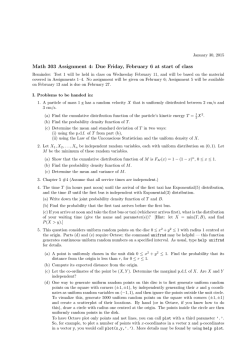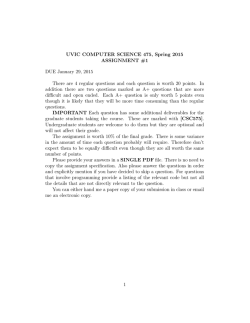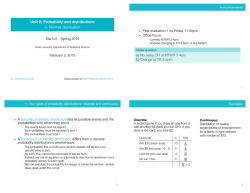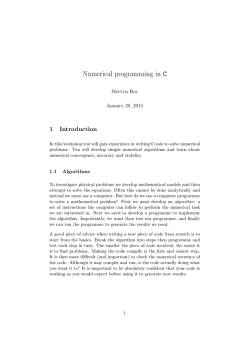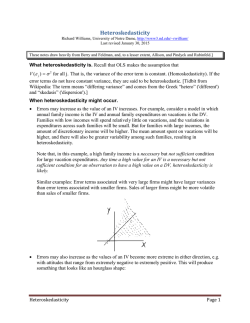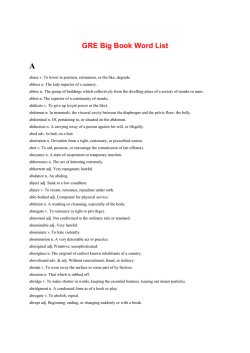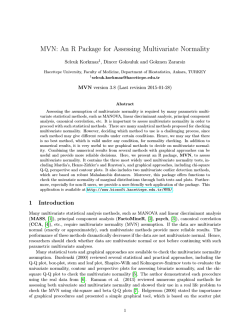
Problema 8.6: R.D. Snee (“Experimenting with a - Academic Uprm
Problema 8.6: R.D. Snee (“Experimenting with a large number of variables,” in experiments in Industry: Design, Analysis and Interpretation of Results, by R. D. Snee, L.B. Hare, and J. B. Trout, Editors, ASQC, 1985) describes an experiment in which a 25-1 design with I = ABCDE was used to investigate the effects of five factors on the color of a chemical product. The factors are A= solvent/reactant, B = catalyst/reactant, C = temperature, D = reactant purity, and E = reactant pH. The results obtained were as follows: Tratamientos Resultados e a b abe c ace bce abc d ade bde abd cde acd bcd abcde -0.63 2.51 -2.68 1.66 2.06 1.22 -2.09 1.93 6.79 5.47 3.45 5.68 5.22 4.38 4.30 4.05 a) Prepare a normal probability plot of the effects. Which effects seem active? Normal Probability Plot of the Effects (response is Results, Alpha = .05) 99 Effect Type Not Significant Significant D 95 90 F actor A B C D E Percent 80 70 60 50 40 30 N ame A B C D E 20 10 5 1 -2 -1 0 1 2 3 4 5 Effect Lenth's PSE = 0.76125 El efecto significativo es la D = pureza del reactante. b) Calculate the residuals. Construct a normal probability plot of the residuals and plot the residuals versus the fitted values. Comment on the plots. R e s idua l P lots for R e s ults No rm al P ro b ab ilit y P lo t o f t h e R esid u als R esid u als V ersu s t h e Fit t ed V alu es 99 2 Residual Percent 90 50 10 1 -4 -2 0 Re sidual 2 0 -2 4 0.0 H ist o g ram o f t h e R esid u als 3.6 4.8 2 2 Residual Frequency 2.4 F itte d V alue R esid u als V ersu s t h e O rd er o f t h e D at a 3 1 0 1.2 0 -2 -3 -2 -1 0 Re sidual 1 2 1 2 3 4 5 6 7 8 9 10 11 12 13 14 15 16 O bse r v a tion O r de r Los residuales muestran un comportamiento aproximadamente normal y al compararlos con los fitted values no se ve un cambio en la varianza poco significativo. c) If any factors are negligible, collapse the 25-1 design into a full factorial in the active factors. Comment on the resulting design, and interpret the results. Factorial Fit: Respuesta versus D Estimated Effects and Coefficients for Respuesta (coded units) Term Effect Constant D 4.420 S = 1.61556 Coef SE Coef T P 2.708 0.4039 6.70 0.000 2.210 0.4039 5.47 0.000 R-Sq = 68.14% R-Sq(adj) = 65.86% Analysis of Variance for Respuesta (coded units) Source DF Seq SS Adj SS Adj MS F P 1 78.146 78.1456 78.146 29.94 0.000 Residual Error 14 36.541 36.5407 2.610 Pure Error 14 36.541 36.5407 2.610 15 114.686 Main Effects Total Unusual Observations for Respuesta Obs StdOrder Respuesta Fit SE Fit Residual 3 3 -2.68000 0.49750 0.57119 -3.17750 St Resid -2.10R R denotes an observation with a large standardized residual. Alias Structure I D Residual Plots for Respuesta Normal Probability Plot of the Residuals Residuals Versus the Fitted Values 99 2 Residual Percent 90 50 10 1 -4 -2 0 Residual 2 0 -2 4 0.0 Histogram of the Residuals 3.6 4.8 2 2 Residual Frequency 2.4 Fitted Value Residuals Versus the Order of the Data 3 1 0 1.2 -3 -2 -1 0 Residual 1 2 0 -2 1 2 3 4 5 6 7 8 9 10 11 12 13 14 15 16 Observation Order Problema 8.8: An article in Industrial and Engineering Chemistry uses a 25-2 design to investigate the effect of A = condensation temperature, B = amount of material 1, C = solvent volume, D = condensation time, and E = amount of material 2 on yield. The results obtained are as follows: Tratamientos Resultados e ab ad bc cd ace bde abcde 23.2 15.5 16.9 16.2 23.8 23.4 16.8 18.1 a) Verify that the design generators used were I = ACE and I = BDE. Factors: Runs: Blocks: 5 8 1 Base Design: Replicates: Center pts (total): 3, 8 1 0 Resolution: Fraction: III 1/4 * NOTE * Some main effects are confounded with two-way interactions. Design Generators: D = ABC, E = AC Alias Structure (up to order 3) I + ACE + BDE A + CE + BCD + ABDE B + DE + ACD + ABCE C + AE + ABD + BCDE D + BE + ABC + ACDE E + AC + BD + ABCDE AB + CD + ADE + BCE AD + BC + ABE + CDE ABCD Los generadores si son ACE y BDE. b) Write down the complete defining relation and the aliases for this design. A = CE = BCD = ABDE B = DE = ACD = ABCE C = AE = ABD = BCDE D = BE = ABC = ACDE E = AC = BD = ABCDE AB = CD = ADE = BCE AD = BC = ABE = CDE ABCD c) Estimate the main effects. Estimated Effects and Coefficients for Respuesta (coded units) Term Constant A B C D E Effect -1.525 -5.175 2.275 -0.675 2.275 S = 2.22626 Coef 19.238 -0.763 -2.587 1.138 -0.337 1.138 SE Coef 0.7871 0.7871 0.7871 0.7871 0.7871 0.7871 R-Sq = 88.95% T 24.44 -0.97 -3.29 1.45 -0.43 1.45 P 0.002 0.435 0.081 0.285 0.710 0.285 R-Sq(adj) = 61.34% Normal Probability Plot of the Effects (response is Respuesta, Alpha = .05) 99 Effect Ty pe Not Significant Significant 95 90 F actor A B C D E Percent 80 70 60 50 40 30 N ame A B C D E 20 10 5 1 -7.5 -5.0 -2.5 0.0 Effect 2.5 5.0 Lenth's PSE = 2.7375 No se ve ningun factor significativo sin embargo se verifico que factor tiene un efecto mayor sobre la respuesta con el siguiente grafico: Main Effects Plot (data means) for Respuesta A 22 B C Mean of Respuesta 20 18 16 -1 1 -1 D 22 1 -1 1 E 20 18 16 -1 1 -1 1 Se observa que B es el que mas impacta la respuesta. d) Prepare an analysis of variance table. Verify that the AB and AD interactions are available to use as error. Analysis of Variance for Respuesta (coded units) Source Main Effects 2-Way Interactions Residual Error Total DF 5 2 0 7 Seq SS 79.826 9.913 * 89.739 Adj SS 79.826 9.913 * Adj MS 15.965 4.956 * F * * P * * Effects Plot for Respuesta Alias Structure I + A*C*E + B*D*E + A*B*C*D A + C*E + B*C*D + A*B*D*E B + D*E + A*C*D + A*B*C*E C + A*E + A*B*D + B*C*D*E D + B*E + A*B*C + A*C*D*E E + A*C + B*D + A*B*C*D*E A*D + B*C + A*B*E + C*D*E A*B + C*D + A*D*E + B*C*E Dejando las interacciones mencionadas por fuera no se obtiene aun grados de libertad para el error. Sabiendo que B es el que mas impacta, se procedió a realizar una anova incluyendo solo el factor B: Factorial Fit: Respuesta versus B Estimated Effects and Coefficients for Respuesta (coded units) Term Constant B Effect Coef 19.238 -2.588 -5.175 S = 2.45552 SE Coef 0.8682 0.8682 R-Sq = 59.69% T 22.16 -2.98 P 0.000 0.025 R-Sq(adj) = 52.97% Analysis of Variance for Respuesta (coded units) Source Main Effects Residual Error Pure Error Total DF 1 6 6 7 Seq SS 53.5612 36.1775 36.1775 89.7388 Adj SS 53.5612 36.1775 36.1775 Adj MS 53.561 6.030 6.030 F 8.88 P 0.025 Unusual Observations for Respuesta Obs 7 StdOrder 2 Respuesta 16.9000 Fit 21.8250 SE Fit 1.2278 Residual -4.9250 St Resid -2.32R R denotes an observation with a large standardized residual. * NOTE * Normal and Pareto effects plots require at least 3 terms. Alias Structure I B e) Plot the residuals versus the fitted values. Also construct a normal probability plot of the residuals. Residual Plots for Respuesta Normal Probability Plot of the Residuals Residuals Versus the Fitted Values 99 Residual Percent 90 50 0.0 -2.5 10 1 -5.0 -5.0 -2.5 0.0 Residual 2.5 5.0 16 18 20 22 Fitted Value Histogram of the Residuals Residuals Versus the Order of the Data 1.5 Residual Frequency 2.0 1.0 0.0 -2.5 0.5 0.0 -5.0 -5 -4 -3 -2 -1 Residual 0 1 2 1 2 3 4 5 6 Observation Order 7 8 Se observa un comportamiento aproximadamente normal, pero parece que a mayor valor en la respuesta mayor varianza en los residuales. Problema 13.9: An experiment was performed to investigate the capability of a measurement system. Ten parts were randomly selected, and two randomly selected operators measured each part three times. The tests were made in random order, and the data below resulted. Part number Operator 1 Operator 2 1 2 3 1 2 3 1 50 49 50 50 48 51 2 52 52 51 51 51 51 3 53 50 50 54 52 51 4 49 51 50 48 50 51 5 48 49 48 48 49 48 6 52 50 50 52 50 50 7 51 51 51 51 50 50 8 52 50 49 53 48 50 9 50 51 50 51 48 49 10 47 46 49 46 47 48 General Linear Model: results versus operador, Part number Factor operador Part number Type random random Levels 2 10 Values 1, 2 1, 2, 3, 4, 5, 6, 7, 8, 9, 10 Analysis of Variance for results, using Adjusted SS for Tests Source operador Part number operador*Part number Error Total DF 1 9 9 40 59 Seq SS 0.417 99.017 5.417 60.000 164.850 Adj SS 0.417 99.017 5.417 60.000 Adj MS 0.417 11.002 0.602 1.500 F 0.69 18.28 0.40 P 0.427 0.000 0.927 Normal Probability Plot of the Residuals (response is results) 99.9 99 Percent 95 90 80 70 60 50 40 30 20 10 5 1 0.1 -3 -2 -1 0 Residual 1 2 3 Según lo anterior la interacción de las partes con el operador no es significativa. b) Find point estimates of the variance components using the analysis of variance method. σ2 = MSE = 1.5 σ2τβ = (MSAB – MSE) / n = (0.6018 - 1.5) / 3 < 0, asumiendo σ2τβ = 0 σ2τ = (MSB – MSAB) / an = (11.0018 - 0.6018) / 2*3 = 1.733 σ2β = (MSA – MSAB) / bn < 0, asumiendo σ2τ = 0
© Copyright 2024
